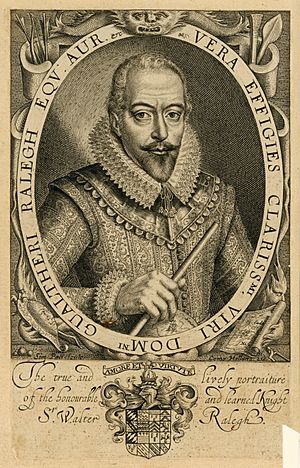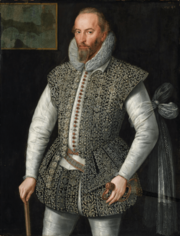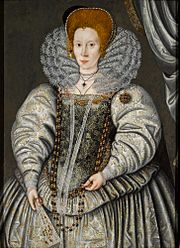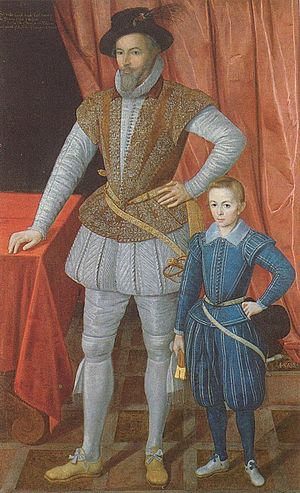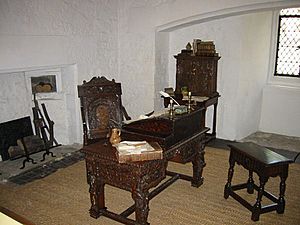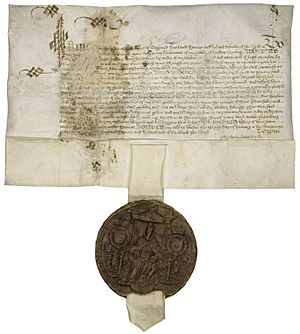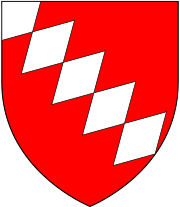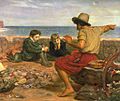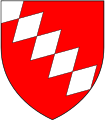Walter Raleigh facts for kids
Quick facts for kids
Sir Walter Raleigh
|
|
|---|---|
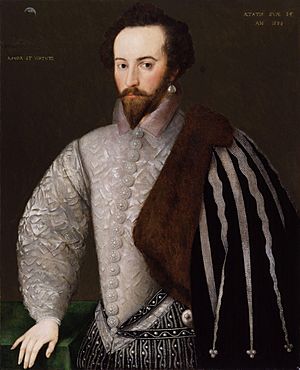
Portrait of Raleigh, 1588
|
|
| Government offices | |
| 1584–1603 | Lord Warden of the Stannaries |
| 1585–1603 | Vice-Admiral of Devon |
| 1587–1603 | Lord Lieutenant of Cornwall |
| 1586–1592 1597–1603 |
Captain of the Yeomen of the Guard |
| 1598–1603 | Custos Rotulorum of Dorset |
| 1600–1603 | Governor of Jersey |
| Parliamentary offices | |
| 1584–1585 1586–1587 |
Member of Parliament for Devonshire |
| 1597–1598 | Member of Parliament for Dorset |
| 1601 | Member of Parliament for Cornwall |
| Personal details | |
| Born | c. 22 January 1552 (or 1554) Hayes Barton, East Budleigh, Devon, England |
| Died | 29 October 1618 (aged approximately 65) London, England |
| Spouse | Elizabeth Throckmorton |
| Children | Damerei Walter "Wat" Carew |
| Alma mater | Oriel College, Oxford |
| Signature | |
| Military service | |
| Battles/wars | Desmond Rebellions French Wars of Religion Spanish Armada |
| Writing career | |
| Notable works |
|
Sir Walter Raleigh (born around 1552 – died 29 October 1618) was a famous English explorer, soldier, writer, and politician. He was one of the most important people during the time of Queen Elizabeth I. Raleigh helped England start colonies in North America. He also helped put down a rebellion in Ireland and defended England from the Spanish Armada. He held many important jobs for Queen Elizabeth I.
Raleigh was born in Devon, England, into a family that followed the Protestant faith. His father was Walter Raleigh, and his mother was Catherine Champernowne. He was the younger half-brother of Sir Humphrey Gilbert. Not much is known about his early life. As a teenager, he fought in religious wars in France. In his twenties, he helped stop a rebellion in Ireland. He also became a landowner there and was even mayor of Youghal. His house, Myrtle Grove, is still there today.
Queen Elizabeth I liked Raleigh very much, and he quickly became important at court. He was made a knight in 1585. The Queen gave him permission to explore Virginia, which helped set up future English settlements. In 1591, he secretly married Elizabeth Throckmorton, one of the Queen's ladies-in-waiting. The Queen was angry because he married without her permission. So, Raleigh and his wife were sent to the Tower of London. After he was released, they lived at his home in Sherborne, Dorset.
In 1594, Raleigh heard stories about a "City of Gold" in South America. He sailed to find it and later wrote a book about his trip. This book helped spread the legend of "El Dorado". After Queen Elizabeth died in 1603, Raleigh was put in the Tower again. This time, it was because he was accused of being part of a plot against the new king, King James I. In 1616, he was let out to search for El Dorado again. During this trip, his men attacked a Spanish town. This broke the rules of his pardon and a peace treaty with Spain. When Raleigh returned to England, he was arrested and executed in 1618 to keep Spain happy.
Contents
- Walter Raleigh's Early Life
- Raleigh's Time in Ireland
- Exploring the New World
- Raleigh's Life in the 1580s
- From 1590 to 1594
- First Trip to Guiana
- From 1596 to 1603
- Trial and Imprisonment
- Second Trip to Guiana
- Execution and What Happened Next
- Interesting Facts About Walter Raleigh
- Walter Raleigh's Poetry
- Images for kids
- See Also
Walter Raleigh's Early Life
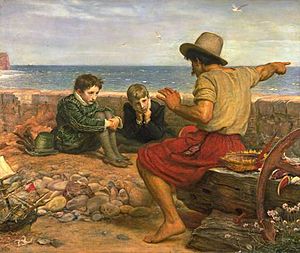
Sir Walter Raleigh was likely born on January 22, 1552, or possibly 1554. He grew up in a house called Hayes Barton in East Budleigh, Devon. He was the youngest of five sons of Walter Raleigh senior.
His mother was Katherine Champernowne. Her aunt, Kat Ashley, was Queen Elizabeth I's governess. She helped Raleigh and his brothers get jobs at the Queen's court. Raleigh's family was Protestant. They had some close calls during the time of Catholic Queen Mary I of England. His father even had to hide to avoid being executed. Because of this, Raleigh grew up disliking Catholicism. He showed this feeling when Protestant Queen Elizabeth I came to power in 1558.
In 1569, Raleigh went to France to fight with the Huguenots in their religious wars. In 1572, he started studying at Oriel College, Oxford. However, he left a year later without finishing his degree. He was known for his clever comments during meetings. Raleigh then continued his education at the Inns of Court, which were like law schools. He later said he never actually studied law. We don't know much about his life between 1569 and 1575. But in his book, History of the World, he said he saw the Battle of Moncontour in France in 1569. Raleigh returned to England in 1575 or 1576.
Raleigh's Time in Ireland
Between 1579 and 1583, Raleigh helped stop the Desmond Rebellions in Ireland. He was at the siege of Smerwick. After the rebellion, Raleigh received a huge amount of land, about 40,000 acres. This land included the town of Youghal and the village of Lismore. He became one of the main landowners in Munster. However, he had trouble getting English people to settle on his lands.
Raleigh lived in Youghal sometimes during his 17 years as an Irish landlord. He was mayor there from 1588 to 1589. His house, Myrtle Grove, is famous for a story. It's said that his servant once threw water on him. The servant thought Raleigh was on fire because he saw smoke from Raleigh's pipe. This story is also told about other places Raleigh lived.
Raleigh became friends with another English landowner in Ireland, the poet Edmund Spenser. In the 1590s, they traveled to London together. Spenser showed Queen Elizabeth I part of his famous poem, The Faerie Queene. Raleigh's management of his Irish lands faced problems. This led to a decrease in his wealth. In 1602, he sold his lands to Richard Boyle, 1st Earl of Cork. Boyle later became very successful under kings James I and Charles I.
Exploring the New World
In 1584, Queen Elizabeth gave Raleigh a special permission, called a royal charter. This allowed him to explore and settle any "remote, heathen and barbarous lands" not owned by other Christian rulers. In return, the Queen would get one-fifth of all the gold and silver found there. The charter said Raleigh had seven years to start a settlement. If he didn't, he would lose his right. Raleigh and Elizabeth hoped to find riches in the New World. They also wanted a base to attack Spanish treasure ships.
Raleigh himself never went to North America. But he did lead trips in 1595 and 1617 to the Orinoco river in South America. He was looking for the golden city of El Dorado. Instead of going himself, he sent others in 1585 to start the Roanoke Colony. This colony later became known as the "Lost Colony." Raleigh and his friends mostly paid for these trips. But they never brought in enough money to keep a colony going in America.
In 1587, Raleigh tried a second time to settle Roanoke Island. This time, a more diverse group of settlers went, including whole families. John White was in charge. After a short time, White returned to England to get more supplies. He planned to be back in a year. But for the Roanoke colonists, one year turned into three. First, Queen Elizabeth I ordered all ships to stay in port. She needed them to fight the Spanish Armada. After England won against the Spanish Armada in 1588, the ships were allowed to sail.
The second delay happened when White's small fleet sailed for Roanoke. His crew wanted to go to Cuba first. They hoped to capture Spanish merchant ships full of treasure. The pilot, a skilled Portuguese sailor hired by Raleigh, described huge riches. This made the crew ignore White's objections to the delay.
When the supply ship finally arrived at Roanoke, three years late, the colonists were gone. The only clue was the word "CROATOAN" and the letters "CRO" carved into tree trunks. White had agreed with the settlers that if they moved, they would carve their new location. This suggested they might have moved to Croatoan Island. However, a hurricane stopped John White from checking the island for survivors. Some people think they starved, or were lost at sea during the stormy weather of 1588. No one tried to contact them again for many years. Whatever happened to the settlers, the place is now known as the ""Lost Colony of Roanoke Island"".
Raleigh's Life in the 1580s
In December 1581, Raleigh came back to England from Ireland. His military company had been disbanded. He became a favorite of Queen Elizabeth I. This was partly because he helped strengthen the Protestant Church in Ireland. In 1585, Raleigh was made a knight. He was also given important jobs, like Lord Warden of the Stannaries, which meant he was in charge of the tin mines in Cornwall and Devon. He was also a Lord Lieutenant of Cornwall and a vice-admiral. He was a member of Parliament for Devonshire in 1585 and 1586. He also received the right to colonize America.
Raleigh asked a shipbuilder named R. Chapman to build a ship for him. It was first called Ark, but then became Ark Raleigh. This was a common practice then, where the ship took its owner's name. Queen Elizabeth I bought the ship from Raleigh in January 1587 for £5,000. This amount was taken off what Raleigh owed the Queen. So, he didn't get cash but a reduction in his debt. The ship was then renamed Ark Royal.
In 1588, when the Spanish Armada threatened England, Raleigh helped with the defense in Devon. The ship he had built, Ark Royal, was the main ship for Lord High Admiral Howard.
From 1590 to 1594
In 1592, Queen Elizabeth gave Raleigh many gifts. These included Durham House in London and the estate of Sherborne, Dorset. He was also made Captain of the Yeomen of the Guard. However, he had not yet received any of the very top government jobs.
In 1591, Raleigh secretly married Elizabeth "Bess" Throckmorton. She was one of the Queen's ladies-in-waiting and 11 years younger than him. She was also expecting a baby at the time. Their son, Damerei, was born but sadly died in October 1592 from the plague. Bess went back to her duties for the Queen. The next year, the Queen found out about the secret marriage. She ordered Raleigh to be put in prison and Bess to be sent away from court. Both were imprisoned in the Tower of London in June 1592.
Raleigh was released from prison in August 1592. He was needed to manage a fleet that had just returned from attacking the Spanish coast. The Queen had called the fleet back. But before they returned, they captured an incredibly rich Spanish merchant ship called Madre de Deus. Raleigh was sent to organize and divide the treasures from the ship. He was sent back to the Tower, but by early 1593, he was released and became a member of Parliament.
It took several years for Raleigh to regain the Queen's full favor. During this time, he traveled a lot. Raleigh and his wife remained very close. They had two more sons: Walter (called Wat) in 1593 and Carew in 1605.
Raleigh was elected to Parliament for Mitchell, Cornwall, in 1593. He moved to his estate at Sherborne. There, he built a new house, finished in 1594, which was called Sherborne Lodge. It has been expanded since then and is now known as Sherborne New Castle. He made friends with local important people. During this time, at a dinner party, Raleigh had a big argument about religion. This led to accusations that Raleigh was an atheist, but the charges were dropped. He was elected to Parliament again, where he spoke about religious and naval matters.
First Trip to Guiana
In 1594, Raleigh learned about a Spanish story of a great golden city. It was said to be at the start of the Caroní River. A year later, he explored what is now Guyana and eastern Venezuela. He was looking for Lake Parime and Manoa, the legendary city of gold. When he returned to England, he published The Discovery of Guiana (1596). This book described his journey and made some exaggerated claims about what he had found. The book helped build the legend of El Dorado. Venezuela does have gold deposits, but there is no proof that Raleigh found any mines. Some people say he discovered Angel Falls, but this is unlikely.
From 1596 to 1603
In 1596, Raleigh helped capture the city of Cádiz in Spain. He was wounded during this battle. He also served as a rear admiral in the Islands Voyage to the Azores in 1597. When he came back from the Azores, Raleigh helped England defend itself. There was a big threat from the 3rd Spanish Armada in the autumn of 1597. The Armada was scattered in the Channel and then destroyed by a storm off Ireland. Lord Howard of Effingham and Raleigh organized a fleet. They captured a Spanish ship that was retreating. This ship had important information about the Spanish plans.
In 1597, Raleigh was chosen as a member of Parliament for Dorset. In 1601, he was chosen for Cornwall. He was unique during Queen Elizabeth's time because he represented three different counties.
From 1600 to 1603, Raleigh was the governor of Jersey, one of the Channel Islands. He improved the island's defenses. This included building a new fort, Fort Isabella Bellissima, which is now called Elizabeth Castle. It protected the area around Saint Helier.
Trial and Imprisonment
By this time, Queen Elizabeth liked Raleigh again. But his good luck did not last. The Queen died on March 24, 1603. Raleigh was arrested on July 19, 1603. He was accused of treason for being involved in a plot against Queen Elizabeth's successor, King James I. He was then put in the Tower of London.
Raleigh's trial began on November 17 in the Great Hall of Winchester Castle. Raleigh defended himself. The main evidence against him was a signed confession from his friend Henry Brooke, 11th Baron Cobham. Raleigh repeatedly asked for Cobham to be called to testify. He said, "Let my accuser come face to face, and be questioned. If this were for a small piece of land, you would have witnesses or good proof. And I am here fighting for my life!" Raleigh argued that the evidence against him was just "hearsay" (something heard from others, not directly). But the court refused to let Cobham testify and be questioned. Raleigh's trial is often mentioned as important for establishing a right to face your accusers in court. Raleigh was found guilty, but King James decided to spare his life.
While in the Tower, Raleigh wrote his unfinished book, The Historie of the World. He used many sources in six different languages. Raleigh wrote about the ancient world, focusing a lot on geography, rather than about England. Raleigh stayed in the Tower until 1616. His son, Carew, was born (in 1604 or 1605) while Raleigh was imprisoned there.
Second Trip to Guiana
In 1617, the King pardoned Raleigh. He was allowed to lead a second trip to Venezuela to search for El Dorado. During this trip, some of Raleigh's men, led by his friend Lawrence Kemys, attacked a Spanish outpost called Santo Tomé de Guayana. This was on the Orinoco river. This attack broke the peace treaties with Spain and went against Raleigh's orders. A condition of Raleigh's pardon was that he must avoid any fighting with Spanish colonies or ships. In the first attack on the settlement, Raleigh's son, Walter, was shot and killed.
When Raleigh returned to England, the Spanish ambassador, Count Gondomar, was very angry. He demanded that King James bring back Raleigh's death sentence. The King had little choice but to do so. Raleigh was brought to London from Plymouth. He had many chances to escape but did not take them.
Execution and What Happened Next
Raleigh was beheaded in the Old Palace Yard at the Palace of Westminster on October 29, 1618.
Raleigh's head was preserved and given to his wife. His body was meant to be buried in the local church in Beddington, Surrey, where Lady Raleigh lived. But it was finally buried in St. Margaret's, Westminster. His tomb is there today. After Raleigh's wife died 29 years later, his head was moved to his tomb and buried at St. Margaret's Church.
Interesting Facts About Walter Raleigh
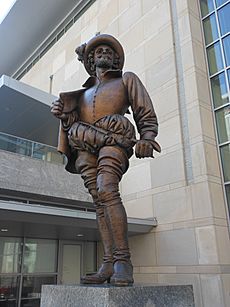
- Raleigh was one of the people who helped make tobacco smoking popular in England.
- Many people at the time, and since, thought his execution was unfair and unnecessary.
- A dance tune called a galliard was written for Raleigh by either Francis Cutting or Richard Allison.
- In 2002, Raleigh was included in the BBC poll of the 100 Greatest Britons.
- The capital city of North Carolina, Raleigh, was named after him in 1792. He had sponsored the Roanoke Colony.
- In Raleigh, North Carolina, there is a bronze statue of Sir Walter. It has been moved to different places in the city. The "Lost Colony" is remembered at the Fort Raleigh National Historic Site on Roanoke Island, North Carolina.
- Raleigh County, West Virginia, is also named after him.
- Mount Raleigh in British Columbia, Canada, was named for him.
- The author George Garrett wrote a historical novel called Death of the Fox. It explores Raleigh's relationships with Queen Elizabeth I and King James I.
Walter Raleigh's Poetry
Raleigh's poems are written in a simple, clear style. C. S. Lewis called Raleigh one of the era's "silver poets." These writers did not use many complex classical references or fancy poetic styles. His writing shows strong personal feelings about love, loss, beauty, and time. Most of his poems are short songs inspired by real events.
In poems like "What is Our Life" and "The Lie", Raleigh expresses a feeling of "contemptus mundi" (disregard for the world). This was more common in the Middle Ages than in his time, which was the start of humanistic optimism. But his longer poem, "The Ocean's Love to Cynthia," combines this feeling with more complex ideas. These ideas are linked to his friends Edmund Spenser and John Donne. The poem shows a sad sense of history. He wrote this poem while he was imprisoned in the Tower of London.
Raleigh wrote a poetic reply to Christopher Marlowe's "The Passionate Shepherd to His Love" (1592). Raleigh's poem was called "The Nymph's Reply to the Shepherd". Both poems were written in the style of traditional pastoral poetry. They both have six four-line stanzas with an AABB rhyme scheme. Raleigh's poem almost line-for-line refutes Marlowe's feelings. Years later, the 20th-century poet William Carlos Williams joined this poetic "argument" with his poem "Raleigh Was Right".
List of Raleigh's Poems
Here are some of the finished and unfinished poems written by Raleigh, or thought to be written by him:
- "The Advice"
- "Another of the Same"
- "Conceit begotten by the Eyes"
- "Epitaph on Sir Philip Sidney"
- "Epitaph on the Earl of Leicester"
- "Even such is Time"
- "The Excuse"
- "False Love"
- "Farewell to the Court"
- "His Petition to Queen Anne of Denmark"
- "If Cynthia be a Queen"
- "In Commendation of George Gascoigne's Steel Glass"
- "The Lie"
- "Like Hermit Poor"
- "Lines from Catullus"
- "Love and Time"
- "My Body in the Walls captive"
- "The Nymph's Reply to the Shepherd"
- "Of Spenser's Faery Queen"
- "On the Snuff of a Candle"
- "The Ocean's Love to Cynthia"
- "A Poem entreating of Sorrow"
- "A Poem put into my Lady Laiton's Pocket"
- "The Pilgrimage"
- "A Prognistication upon Cards and Dice"
- "The Shepherd's Praise of Diana"
- "Sweet Unsure"
- "To His Mistress"
- "To the Translator of Lucan's Pharsalia"
- "What is Our Life?"
- "The Wood, the Weed, the Wag"
Images for kids
See Also
 In Spanish: Walter Raleigh para niños
In Spanish: Walter Raleigh para niños


